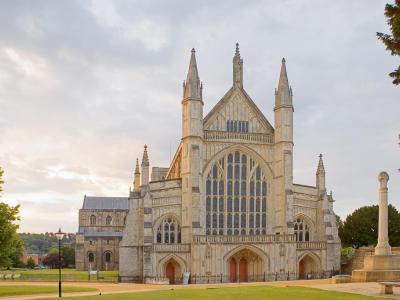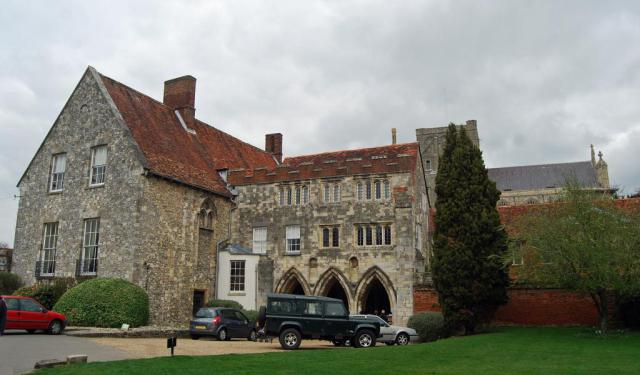
Winchester Cathedral, Winchester (must see)
Winchester Cathedral, formally known as the Cathedral Church of the Holy Trinity, Saint Peter, Saint Paul, and Saint Swithun, stands among the grandest cathedrals in Northern Europe. Serving as the seat of the Bishop of Winchester, it represents the ecclesiastical heart of the ancient Diocese of Winchester.
The cathedral, spanning from 1079 to 1532, honors numerous saints, particularly Saint Swithun of Winchester, and presents an impressive array of architectural styles, showcasing Norman transepts, an Early English retrochoir, and a Perpendicular Gothic style in its extensive nave. Its length spans an impressive 558 feet, marking it as the longest medieval cathedral globally, surpassed only by more recent constructions like Saint Peter's Basilica in Rome.
Built from a variety of stones—such as Quarr limestone from the Isle of Wight, Bath stone or Oolite, Caen stone from Normandy, ashlar, Beer stone, and Purbeck Marble—the cathedral displays the evolution of architectural styles. The structure's design includes a cruciform plan, featuring an extensive nave, transepts, central tower, choir, presbytery, and lady chapel.
The building incorporates significant sections constructed during the 11th century, notably the north and south transepts erected between 1079 and 1098 under Bishop Walkelin. The central tower, reconstructed in the Norman style post its collapse in 1107, offers insights hinting at its original intention for a grander structure, reflected in its elaborate interior features. The nave, initially completed between c.1100 and c.1129, underwent a Perpendicular Gothic remodeling from 1346 to 1420 while retaining much of the original Norman work.
Underneath the cathedral lies the extensive Norman-built crypt, featuring a notable statue by Antony Gormley and frequently facing winter flooding due to a high water table.
In contemporary times, the cathedral attracts numerous tourists due to its connection with Jane Austen, who passed away in Winchester on July 18, 1817. The cathedral served as the venue for her funeral, and her final resting place is in the north aisle.
The cathedral, spanning from 1079 to 1532, honors numerous saints, particularly Saint Swithun of Winchester, and presents an impressive array of architectural styles, showcasing Norman transepts, an Early English retrochoir, and a Perpendicular Gothic style in its extensive nave. Its length spans an impressive 558 feet, marking it as the longest medieval cathedral globally, surpassed only by more recent constructions like Saint Peter's Basilica in Rome.
Built from a variety of stones—such as Quarr limestone from the Isle of Wight, Bath stone or Oolite, Caen stone from Normandy, ashlar, Beer stone, and Purbeck Marble—the cathedral displays the evolution of architectural styles. The structure's design includes a cruciform plan, featuring an extensive nave, transepts, central tower, choir, presbytery, and lady chapel.
The building incorporates significant sections constructed during the 11th century, notably the north and south transepts erected between 1079 and 1098 under Bishop Walkelin. The central tower, reconstructed in the Norman style post its collapse in 1107, offers insights hinting at its original intention for a grander structure, reflected in its elaborate interior features. The nave, initially completed between c.1100 and c.1129, underwent a Perpendicular Gothic remodeling from 1346 to 1420 while retaining much of the original Norman work.
Underneath the cathedral lies the extensive Norman-built crypt, featuring a notable statue by Antony Gormley and frequently facing winter flooding due to a high water table.
In contemporary times, the cathedral attracts numerous tourists due to its connection with Jane Austen, who passed away in Winchester on July 18, 1817. The cathedral served as the venue for her funeral, and her final resting place is in the north aisle.
Want to visit this sight? Check out these Self-Guided Walking Tours in Winchester. Alternatively, you can download the mobile app "GPSmyCity: Walks in 1K+ Cities" from Apple App Store or Google Play Store. The app turns your mobile device to a personal tour guide and it works offline, so no data plan is needed when traveling abroad.
Winchester Cathedral on Map
Sight Name: Winchester Cathedral
Sight Location: Winchester, England (See walking tours in Winchester)
Sight Type: Religious
Guide(s) Containing This Sight:
Sight Location: Winchester, England (See walking tours in Winchester)
Sight Type: Religious
Guide(s) Containing This Sight:
Walking Tours in Winchester, England
Create Your Own Walk in Winchester
Creating your own self-guided walk in Winchester is easy and fun. Choose the city attractions that you want to see and a walk route map will be created just for you. You can even set your hotel as the start point of the walk.
Winchester Cathedral Close Walk
Winchester Cathedral, originally built in 1079, is the longest Gothic cathedral in Europe. It contains much fine architecture spanning the 11th to the 16th centuries and is the place of interment of numerous Bishops of Winchester (such as William of Wykeham), Anglo-Saxon monarchs (such as Egbert of Wessex), and later monarchs such as King Canute and William Rufus. It was once an important... view more
Tour Duration: 1 Hour(s)
Travel Distance: 0.8 Km or 0.5 Miles
Tour Duration: 1 Hour(s)
Travel Distance: 0.8 Km or 0.5 Miles
Winchester's Historical Buildings Walking Tour
Are you an explorer at heart and with a keen interest in history? If you answer yes to both of these and happen to be in Winchester, Hampshire, then you've hit the right spot! There are several historical locations in town, including time-honored buildings, monuments, and palaces, through which you can learn much about its glorious past.
The abundance of such sites makes a walk around... view more
Tour Duration: 2 Hour(s)
Travel Distance: 3.1 Km or 1.9 Miles
The abundance of such sites makes a walk around... view more
Tour Duration: 2 Hour(s)
Travel Distance: 3.1 Km or 1.9 Miles
Winchester Introduction Walking Tour
Winchester, the county town of Hampshire, England, is a charming place with a great deal of history.
The name, Winchester, is traced back to its Old English origins, derived from "Wintan-ceaster" which means "Fort Venta". The city itself emerged in Roman times when it was known as Venta Belgarum, in which Venta was a common Celtic word for a "tribal town" or... view more
Tour Duration: 2 Hour(s)
Travel Distance: 3.7 Km or 2.3 Miles
The name, Winchester, is traced back to its Old English origins, derived from "Wintan-ceaster" which means "Fort Venta". The city itself emerged in Roman times when it was known as Venta Belgarum, in which Venta was a common Celtic word for a "tribal town" or... view more
Tour Duration: 2 Hour(s)
Travel Distance: 3.7 Km or 2.3 Miles



